Fuji Ren
SSG-Dit: A Spatial Signal Guided Framework for Controllable Video Generation
Aug 23, 2025Abstract:Controllable video generation aims to synthesize video content that aligns precisely with user-provided conditions, such as text descriptions and initial images. However, a significant challenge persists in this domain: existing models often struggle to maintain strong semantic consistency, frequently generating videos that deviate from the nuanced details specified in the prompts. To address this issue, we propose SSG-DiT (Spatial Signal Guided Diffusion Transformer), a novel and efficient framework for high-fidelity controllable video generation. Our approach introduces a decoupled two-stage process. The first stage, Spatial Signal Prompting, generates a spatially aware visual prompt by leveraging the rich internal representations of a pre-trained multi-modal model. This prompt, combined with the original text, forms a joint condition that is then injected into a frozen video DiT backbone via our lightweight and parameter-efficient SSG-Adapter. This unique design, featuring a dual-branch attention mechanism, allows the model to simultaneously harness its powerful generative priors while being precisely steered by external spatial signals. Extensive experiments demonstrate that SSG-DiT achieves state-of-the-art performance, outperforming existing models on multiple key metrics in the VBench benchmark, particularly in spatial relationship control and overall consistency.
Beyond Empathy: Integrating Diagnostic and Therapeutic Reasoning with Large Language Models for Mental Health Counseling
May 21, 2025Abstract:Large language models (LLMs) hold significant potential for mental health support, capable of generating empathetic responses and simulating therapeutic conversations. However, existing LLM-based approaches often lack the clinical grounding necessary for real-world psychological counseling, particularly in explicit diagnostic reasoning aligned with standards like the DSM/ICD and incorporating diverse therapeutic modalities beyond basic empathy or single strategies. To address these critical limitations, we propose PsyLLM, the first large language model designed to systematically integrate both diagnostic and therapeutic reasoning for mental health counseling. To develop the PsyLLM, we propose a novel automated data synthesis pipeline. This pipeline processes real-world mental health posts, generates multi-turn dialogue structures, and leverages LLMs guided by international diagnostic standards (e.g., DSM/ICD) and multiple therapeutic frameworks (e.g., CBT, ACT, psychodynamic) to simulate detailed clinical reasoning processes. Rigorous multi-dimensional filtering ensures the generation of high-quality, clinically aligned dialogue data. In addition, we introduce a new benchmark and evaluation protocol, assessing counseling quality across four key dimensions: comprehensiveness, professionalism, authenticity, and safety. Our experiments demonstrate that PsyLLM significantly outperforms state-of-the-art baseline models on this benchmark.
Road Rage Reasoning with Vision-language Models (VLMs): Task Definition and Evaluation Dataset
Mar 14, 2025Abstract:Road rage, triggered by driving-related stimuli such as traffic congestion and aggressive driving, poses a significant threat to road safety. Previous research on road rage regulation has primarily focused on response suppression, lacking proactive prevention capabilities. With the advent of Vision-Language Models (VLMs), it has become possible to reason about trigger events visually and then engage in dialog-based comforting before drivers' anger escalates. To this end, we propose the road rage reasoning task, along with a finely annotated test dataset and evaluation metrics, to assess the capabilities of current mainstream VLMs in scene understanding, event recognition, and road rage reasoning. The results indicate that current VLMs exhibit significant shortcomings in scene understanding within the visual modality, as well as in comprehending the spatial relationships between objects in the textual modality. Improving VLMs' performance in these areas will greatly benefit downstream tasks like antecedent-focused road rage regulation.
MDEval: Evaluating and Enhancing Markdown Awareness in Large Language Models
Jan 25, 2025Abstract:Large language models (LLMs) are expected to offer structured Markdown responses for the sake of readability in web chatbots (e.g., ChatGPT). Although there are a myriad of metrics to evaluate LLMs, they fail to evaluate the readability from the view of output content structure. To this end, we focus on an overlooked yet important metric -- Markdown Awareness, which directly impacts the readability and structure of the content generated by these language models. In this paper, we introduce MDEval, a comprehensive benchmark to assess Markdown Awareness for LLMs, by constructing a dataset with 20K instances covering 10 subjects in English and Chinese. Unlike traditional model-based evaluations, MDEval provides excellent interpretability by combining model-based generation tasks and statistical methods. Our results demonstrate that MDEval achieves a Spearman correlation of 0.791 and an accuracy of 84.1% with human, outperforming existing methods by a large margin. Extensive experimental results also show that through fine-tuning over our proposed dataset, less performant open-source models are able to achieve comparable performance to GPT-4o in terms of Markdown Awareness. To ensure reproducibility and transparency, MDEval is open sourced at https://github.com/SWUFE-DB-Group/MDEval-Benchmark.
Bridging the User-side Knowledge Gap in Knowledge-aware Recommendations with Large Language Models
Dec 18, 2024



Abstract:In recent years, knowledge graphs have been integrated into recommender systems as item-side auxiliary information, enhancing recommendation accuracy. However, constructing and integrating structural user-side knowledge remains a significant challenge due to the improper granularity and inherent scarcity of user-side features. Recent advancements in Large Language Models (LLMs) offer the potential to bridge this gap by leveraging their human behavior understanding and extensive real-world knowledge. Nevertheless, integrating LLM-generated information into recommender systems presents challenges, including the risk of noisy information and the need for additional knowledge transfer. In this paper, we propose an LLM-based user-side knowledge inference method alongside a carefully designed recommendation framework to address these challenges. Our approach employs LLMs to infer user interests based on historical behaviors, integrating this user-side information with item-side and collaborative data to construct a hybrid structure: the Collaborative Interest Knowledge Graph (CIKG). Furthermore, we propose a CIKG-based recommendation framework that includes a user interest reconstruction module and a cross-domain contrastive learning module to mitigate potential noise and facilitate knowledge transfer. We conduct extensive experiments on three real-world datasets to validate the effectiveness of our method. Our approach achieves state-of-the-art performance compared to competitive baselines, particularly for users with sparse interactions.
A Review of Human Emotion Synthesis Based on Generative Technology
Dec 10, 2024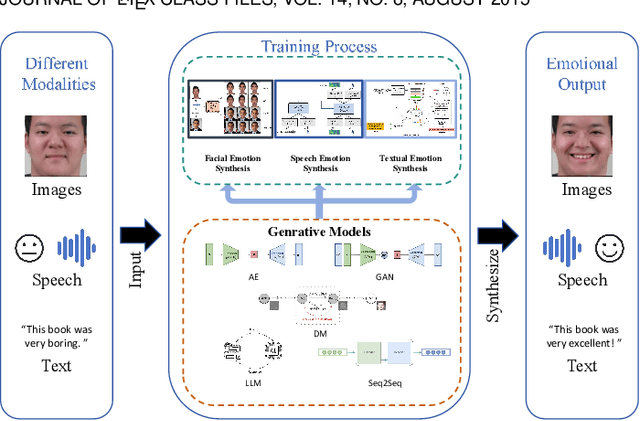
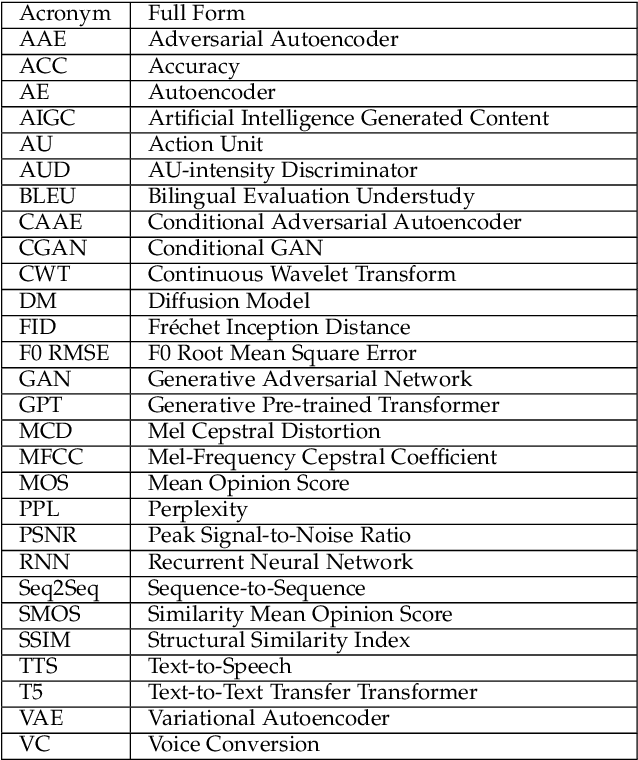
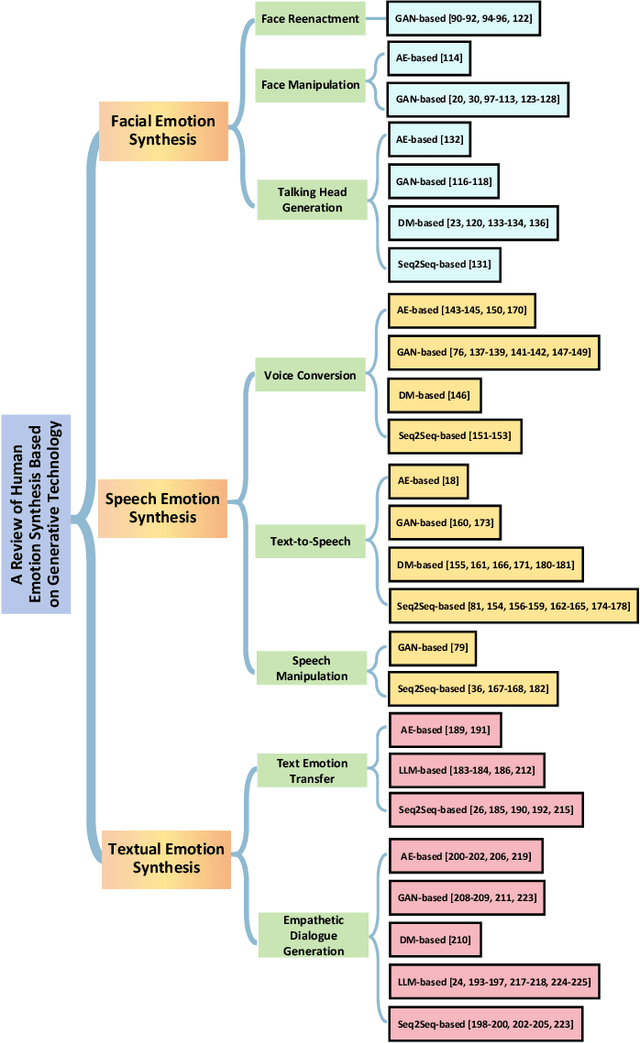

Abstract:Human emotion synthesis is a crucial aspect of affective computing. It involves using computational methods to mimic and convey human emotions through various modalities, with the goal of enabling more natural and effective human-computer interactions. Recent advancements in generative models, such as Autoencoders, Generative Adversarial Networks, Diffusion Models, Large Language Models, and Sequence-to-Sequence Models, have significantly contributed to the development of this field. However, there is a notable lack of comprehensive reviews in this field. To address this problem, this paper aims to address this gap by providing a thorough and systematic overview of recent advancements in human emotion synthesis based on generative models. Specifically, this review will first present the review methodology, the emotion models involved, the mathematical principles of generative models, and the datasets used. Then, the review covers the application of different generative models to emotion synthesis based on a variety of modalities, including facial images, speech, and text. It also examines mainstream evaluation metrics. Additionally, the review presents some major findings and suggests future research directions, providing a comprehensive understanding of the role of generative technology in the nuanced domain of emotion synthesis.
Generative Technology for Human Emotion Recognition: A Scope Review
Jul 04, 2024



Abstract:Affective computing stands at the forefront of artificial intelligence (AI), seeking to imbue machines with the ability to comprehend and respond to human emotions. Central to this field is emotion recognition, which endeavors to identify and interpret human emotional states from different modalities, such as speech, facial images, text, and physiological signals. In recent years, important progress has been made in generative models, including Autoencoder, Generative Adversarial Network, Diffusion Model, and Large Language Model. These models, with their powerful data generation capabilities, emerge as pivotal tools in advancing emotion recognition. However, up to now, there remains a paucity of systematic efforts that review generative technology for emotion recognition. This survey aims to bridge the gaps in the existing literature by conducting a comprehensive analysis of over 320 research papers until June 2024. Specifically, this survey will firstly introduce the mathematical principles of different generative models and the commonly used datasets. Subsequently, through a taxonomy, it will provide an in-depth analysis of how generative techniques address emotion recognition based on different modalities in several aspects, including data augmentation, feature extraction, semi-supervised learning, cross-domain, etc. Finally, the review will outline future research directions, emphasizing the potential of generative models to advance the field of emotion recognition and enhance the emotional intelligence of AI systems.
MSSTNet: A Multi-Scale Spatio-Temporal CNN-Transformer Network for Dynamic Facial Expression Recognition
Apr 12, 2024



Abstract:Unlike typical video action recognition, Dynamic Facial Expression Recognition (DFER) does not involve distinct moving targets but relies on localized changes in facial muscles. Addressing this distinctive attribute, we propose a Multi-Scale Spatio-temporal CNN-Transformer network (MSSTNet). Our approach takes spatial features of different scales extracted by CNN and feeds them into a Multi-scale Embedding Layer (MELayer). The MELayer extracts multi-scale spatial information and encodes these features before sending them into a Temporal Transformer (T-Former). The T-Former simultaneously extracts temporal information while continually integrating multi-scale spatial information. This process culminates in the generation of multi-scale spatio-temporal features that are utilized for the final classification. Our method achieves state-of-the-art results on two in-the-wild datasets. Furthermore, a series of ablation experiments and visualizations provide further validation of our approach's proficiency in leveraging spatio-temporal information within DFER.
* Accepted to 2024 IEEE International Conference on Acoustics, Speech, and Signal Processing (ICASSP 2024)
SSP: A Simple and Safe automatic Prompt engineering method towards realistic image synthesis on LVM
Jan 02, 2024Abstract:Recently, text-to-image (T2I) synthesis has undergone significant advancements, particularly with the emergence of Large Language Models (LLM) and their enhancement in Large Vision Models (LVM), greatly enhancing the instruction-following capabilities of traditional T2I models. Nevertheless, previous methods focus on improving generation quality but introduce unsafe factors into prompts. We explore that appending specific camera descriptions to prompts can enhance safety performance. Consequently, we propose a simple and safe prompt engineering method (SSP) to improve image generation quality by providing optimal camera descriptions. Specifically, we create a dataset from multi-datasets as original prompts. To select the optimal camera, we design an optimal camera matching approach and implement a classifier for original prompts capable of automatically matching. Appending camera descriptions to original prompts generates optimized prompts for further LVM image generation. Experiments demonstrate that SSP improves semantic consistency by an average of 16% compared to others and safety metrics by 48.9%.
Bert4CMR: Cross-Market Recommendation with Bidirectional Encoder Representations from Transformer
May 24, 2023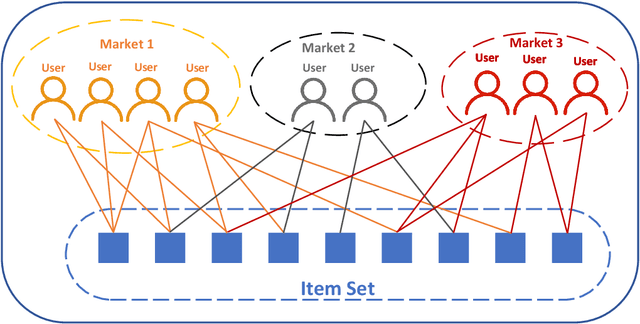
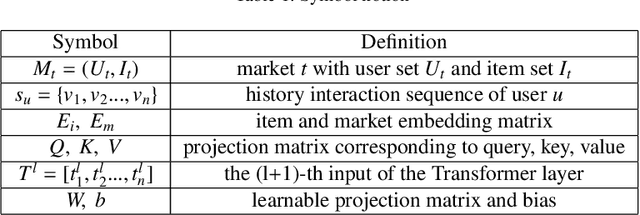
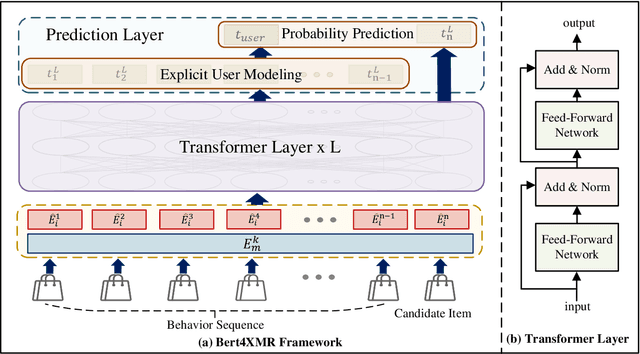

Abstract:Real-world multinational e-commerce companies, such as Amazon and eBay, serve in multiple countries and regions. Obviously, these markets have similar goods but different users. Some markets are data-scarce, while others are data-rich. In recent years, cross-market recommendation (CMR) has been proposed to enhance data-scarce markets by leveraging auxiliary information from data-rich markets. Previous works fine-tune the pre-trained model on the local market after freezing part of the parameters or introducing inter-market similarity into the local market to improve the performance of CMR. However, they generally do not consider eliminating the mutual interference between markets. Therefore, the existing methods are neither unable to learn unbiased general knowledge nor efficient transfer reusable information across markets. In this paper, we propose a novel attention-based model called Bert4CMR to simultaneously improve all markets' recommendation performance. Specifically, we employ the attention mechanism to capture user interests by modelling user behavioural sequences. We pre-train the proposed model on global data to learn the general knowledge of items. Then we fine-tune specific target markets to perform local recommendations. We propose market embedding to model the bias of each market and reduce the mutual inference between the parallel markets. Extensive experiments conducted on seven markets show that our model is state-of-the-art. Our model outperforms the suboptimal model by 4.82%, 4.73%, 7.66% and 6.49% on average of seven datasets in terms of four metrics, respectively. We conduct ablation experiments to analyse the effectiveness of the proposed components. Experimental results indicate that our model is able to learn general knowledge through global data and shield the mutual interference between markets.
 Add to Chrome
Add to Chrome Add to Firefox
Add to Firefox Add to Edge
Add to Edge